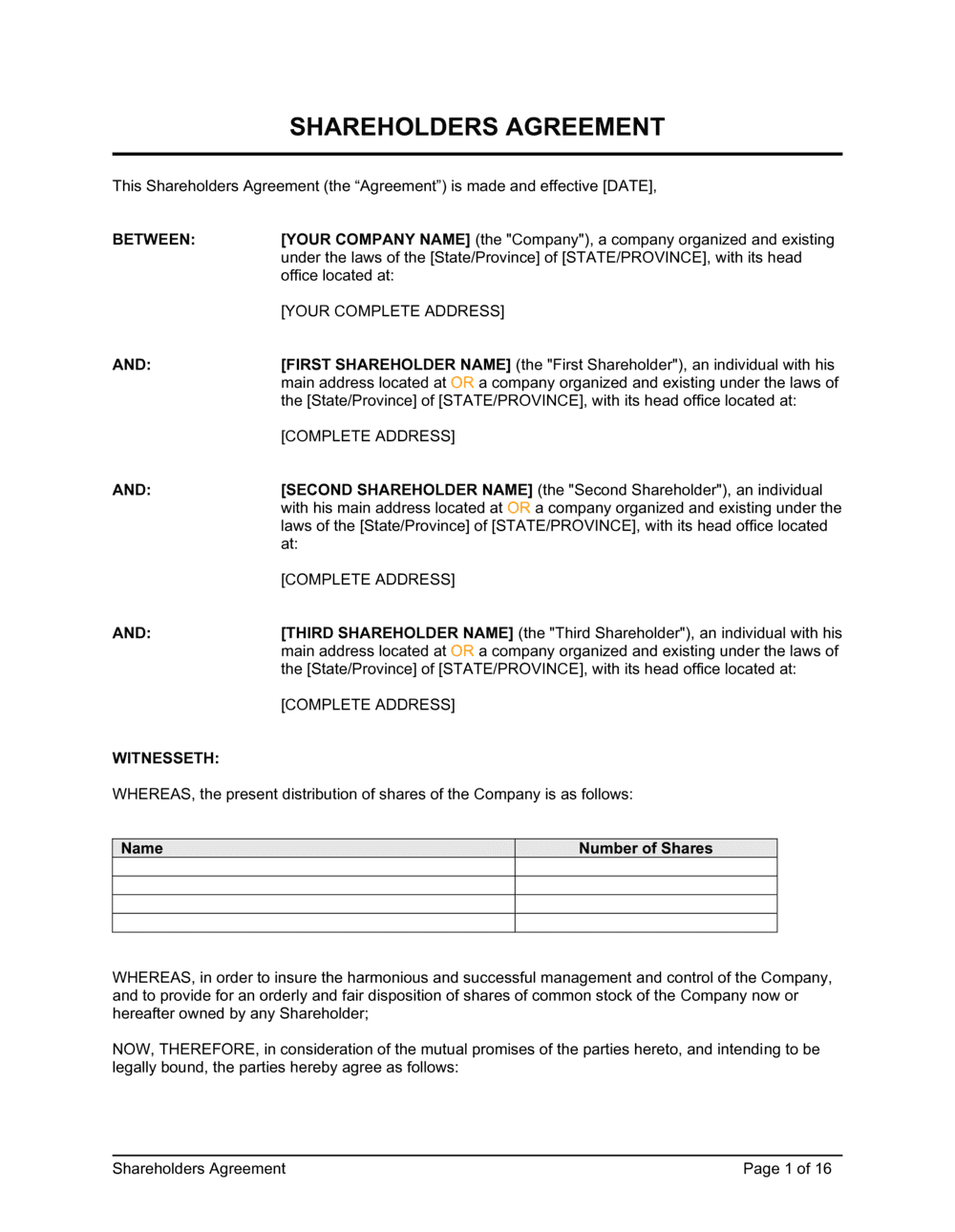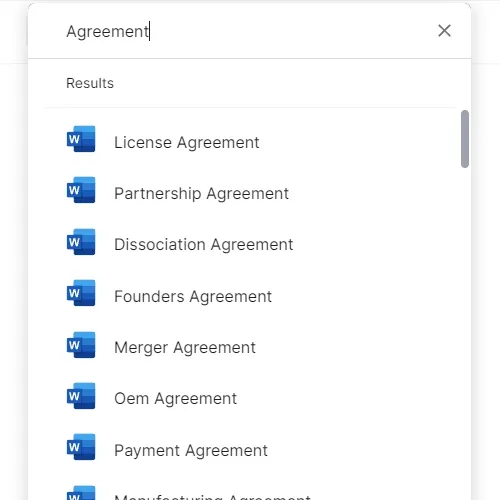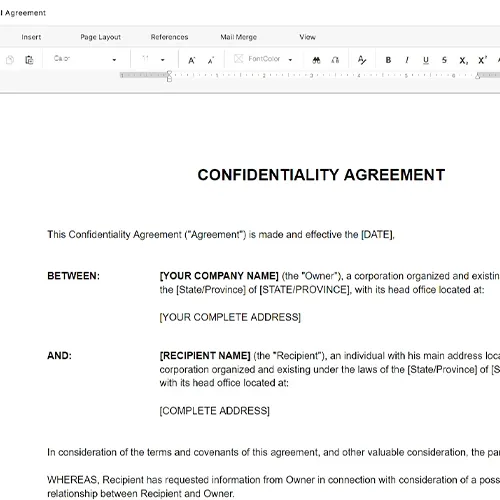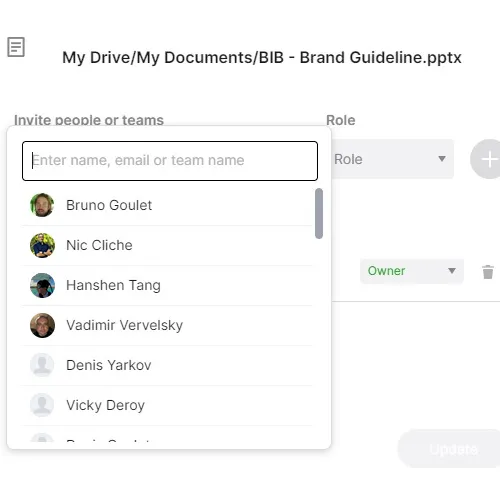Shareholders Agreement Template

Strengthening Corporate Governance with a Shareholders Agreement
In the complex world of corporate governance, maintaining clear and mutual understanding among shareholders is critical for the success and stability of a corporation. A Shareholders Agreement is a vital document that formalizes the relationship among shareholders, outlining the terms and conditions under which the company will operate. This agreement ensures that all parties clearly understand their rights, obligations, and expectations, fostering a cooperative and transparent corporate environment.
A Shareholders Agreement is essential for defining the parameters of the shareholder relationship, including ownership rights, management responsibilities, profit distribution, and procedures for resolving disputes. It provides a legal framework that supports the smooth and effective operation of the corporation, ensuring that the interests of all shareholders are protected.
What is a Shareholders Agreement Template?
A Shareholders Agreement template is a comprehensive guide for drafting detailed agreements that govern the relationships among shareholders. It ensures that all critical elements are addressed, including shareholder roles, voting rights, share transfer restrictions, and dispute resolution mechanisms. Utilizing a template streamlines the creation process, ensuring consistency and thoroughness while allowing for customization to fit the specific needs and requirements of the corporation and its shareholders.
Key Elements of a Shareholders Agreement
A robust Shareholders Agreement should thoroughly address the following key elements:
- Identification of Parties - Clearly identifies the corporation and its shareholders, including their respective roles and ownership interests.
- Purpose and Scope - Defines the purpose of the agreement, including the specific goals and objectives it aims to achieve.
- Shareholder Contributions - Details the initial capital contributions of each shareholder, whether in the form of cash, assets, or services, and outlines procedures for additional contributions.
- Voting Rights - Specifies the voting rights of shareholders, including the procedures for casting votes and making major corporate decisions.
- Board of Directors - Outlines the composition and election of the board of directors, including the rights and responsibilities of board members.
- Profit and Loss Distribution - Details how profits and losses will be allocated among shareholders, typically in proportion to their ownership interests.
- Meetings and Quorums - Establishes the procedures for holding shareholder meetings, including quorum requirements and voting thresholds.
- Share Transfer Restrictions - Outlines the procedures and restrictions for transferring shares, ensuring the stability and continuity of ownership.
- Dispute Resolution - Includes provisions for resolving disputes among shareholders, typically through mediation or arbitration, to avoid litigation and maintain a cooperative relationship.
- Confidentiality - Protects sensitive corporate information shared among shareholders and management.
- Dissolution - Defines the conditions under which the corporation can be dissolved, including procedures for winding down and distributing remaining assets.
Supporting Documents for a Shareholder Agreement
To enhance the functionality and comprehensiveness of a Shareholder's Agreement, integrating the following supporting documents is advisable:
- General Bylaws - Establishes the internal rules and procedures for the corporation’s governance, aligning with the shareholder's agreement.
- Non-Disclosure Agreement (NDA) - Protects confidential information exchanged among shareholders during their relationship.
- Buy-Sell Agreement - Outlines the procedures for buying out a shareholder’s interest or selling shares, ensuring smooth transitions.
Why Employ a Shareholders Agreement Template?
Utilizing a detailed template for drafting your Shareholder's Agreement offers significant benefits:
- Clarity and Precision - Ensures that all necessary information is clearly presented, reducing the likelihood of misunderstandings or miscommunications.
- Professionalism - Projects a professional image, demonstrating to stakeholders that the corporation is well-governed and that operations are conducted systematically and transparently.
- Efficiency - Streamlines the agreement preparation process, saving time and resources that can be better allocated to strategic initiatives.
- Risk Mitigation - Reduces potential legal disputes by clearly defining roles, responsibilities, and profit-sharing agreements.
- Compliance - Ensures that the agreement adheres to legal and regulatory requirements, reducing the risk of non-compliance and potential legal issues.
Adopting a comprehensive Shareholders Agreement is essential for effective corporate governance. It provides a clear, enforceable framework that aligns shareholders and management with their mutual goals, ensuring that the corporation operates smoothly and remains compliant with legal requirements. This fundamental document facilitates operational efficacy and solidifies the commitment to strategic growth and corporate integrity.
Reviewed on

Strengthening Corporate Governance with a Shareholders Agreement
In the complex world of corporate governance, maintaining clear and mutual understanding among shareholders is critical for the success and stability of a corporation. A Shareholders Agreement is a vital document that formalizes the relationship among shareholders, outlining the terms and conditions under which the company will operate. This agreement ensures that all parties clearly understand their rights, obligations, and expectations, fostering a cooperative and transparent corporate environment.
A Shareholders Agreement is essential for defining the parameters of the shareholder relationship, including ownership rights, management responsibilities, profit distribution, and procedures for resolving disputes. It provides a legal framework that supports the smooth and effective operation of the corporation, ensuring that the interests of all shareholders are protected.
What is a Shareholders Agreement Template?
A Shareholders Agreement template is a comprehensive guide for drafting detailed agreements that govern the relationships among shareholders. It ensures that all critical elements are addressed, including shareholder roles, voting rights, share transfer restrictions, and dispute resolution mechanisms. Utilizing a template streamlines the creation process, ensuring consistency and thoroughness while allowing for customization to fit the specific needs and requirements of the corporation and its shareholders.
Key Elements of a Shareholders Agreement
A robust Shareholders Agreement should thoroughly address the following key elements:
- Identification of Parties - Clearly identifies the corporation and its shareholders, including their respective roles and ownership interests.
- Purpose and Scope - Defines the purpose of the agreement, including the specific goals and objectives it aims to achieve.
- Shareholder Contributions - Details the initial capital contributions of each shareholder, whether in the form of cash, assets, or services, and outlines procedures for additional contributions.
- Voting Rights - Specifies the voting rights of shareholders, including the procedures for casting votes and making major corporate decisions.
- Board of Directors - Outlines the composition and election of the board of directors, including the rights and responsibilities of board members.
- Profit and Loss Distribution - Details how profits and losses will be allocated among shareholders, typically in proportion to their ownership interests.
- Meetings and Quorums - Establishes the procedures for holding shareholder meetings, including quorum requirements and voting thresholds.
- Share Transfer Restrictions - Outlines the procedures and restrictions for transferring shares, ensuring the stability and continuity of ownership.
- Dispute Resolution - Includes provisions for resolving disputes among shareholders, typically through mediation or arbitration, to avoid litigation and maintain a cooperative relationship.
- Confidentiality - Protects sensitive corporate information shared among shareholders and management.
- Dissolution - Defines the conditions under which the corporation can be dissolved, including procedures for winding down and distributing remaining assets.
Supporting Documents for a Shareholder Agreement
To enhance the functionality and comprehensiveness of a Shareholder's Agreement, integrating the following supporting documents is advisable:
- General Bylaws - Establishes the internal rules and procedures for the corporation’s governance, aligning with the shareholder's agreement.
- Non-Disclosure Agreement (NDA) - Protects confidential information exchanged among shareholders during their relationship.
- Buy-Sell Agreement - Outlines the procedures for buying out a shareholder’s interest or selling shares, ensuring smooth transitions.
Why Employ a Shareholders Agreement Template?
Utilizing a detailed template for drafting your Shareholder's Agreement offers significant benefits:
- Clarity and Precision - Ensures that all necessary information is clearly presented, reducing the likelihood of misunderstandings or miscommunications.
- Professionalism - Projects a professional image, demonstrating to stakeholders that the corporation is well-governed and that operations are conducted systematically and transparently.
- Efficiency - Streamlines the agreement preparation process, saving time and resources that can be better allocated to strategic initiatives.
- Risk Mitigation - Reduces potential legal disputes by clearly defining roles, responsibilities, and profit-sharing agreements.
- Compliance - Ensures that the agreement adheres to legal and regulatory requirements, reducing the risk of non-compliance and potential legal issues.
Adopting a comprehensive Shareholders Agreement is essential for effective corporate governance. It provides a clear, enforceable framework that aligns shareholders and management with their mutual goals, ensuring that the corporation operates smoothly and remains compliant with legal requirements. This fundamental document facilitates operational efficacy and solidifies the commitment to strategic growth and corporate integrity.
Easily Create Any Business Document You Need in Minutes.

Download or open template
Access over 3,000+ business and legal templates for any business task, project or initiative.

Edit and fill in the blanks
Customize your ready-made business document template and save it in the cloud.

Save, Share, Export, or Sign
Share your files and folders with your team. Create a space of seamless collaboration.


